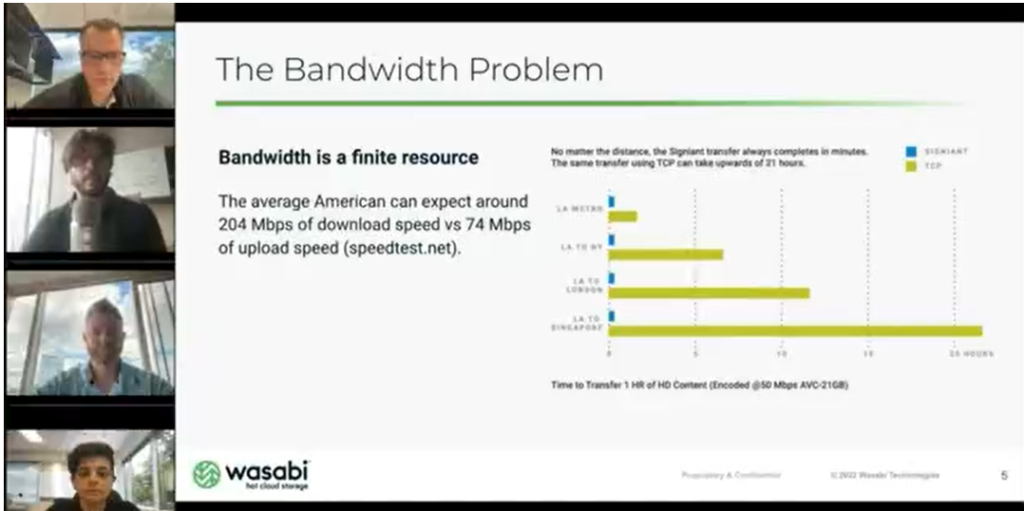M+E Connections

How Wasabi and Signiant Can Help M&E Companies Jet to the Cloud at Hyperspeeds
Story Highlights
Increasingly large video file sizes have presented a major challenge to media and entertainment organizations looking to modernize their storage operations by moving data to the cloud, according to Wasabi Technologies and Signiant.
However, now, with best-of-breed cloud object storage and file acceleration, the cloud has never felt closer and it’s possible to supercharge an organization’s uploads and scale its storage using the technology solutions of Wasabi and Signiant, product managers from the companies said Sept. 1 during the webinar “Jet to the Cloud at Hyperspeeds With Signiant and Wasabi.”
During the webinar, they discussed how file acceleration through the Signiant Jet Software-as-a-Service (SaaS) and Wasabi hot cloud storage solutions work together to transform media storage, how to configure Signiant Jet with an organization’s Wasabi bucket, and how to take advantage of the 90-day free Jet subscription that is available exclusively to Wasabi customers.
First, Ben Bonadies, product marketing manager at Wasabi and the webinar’s host, touted the main features and benefits of Wasabi’s cloud storage system.
It is “cloud storage plain and simple and our value proposition can be best broken down [to] price, performance, and protection” advantages compared to rival offerings, he told viewers. To be precise, Wasabi is “hot cloud storage, meaning your data is always active [and] can be pulled down in a moment’s notice without any latency,” he explained.
Wasabi’s solution also offers “immutable storage options at the bucket and object level, which is a great defense against things like ransomware,” he said, noting “immutable storage, for those who aren’t aware, is a feature which allows data to be rendered completely immutable, meaning it cannot be deleted or changed by anybody.”
 Next, Mona Noor, product manager at Signiant, touted the benefits of Jet, which she called the “easiest, fastest way to automate point to point transfers between your locations and your partners and to and from the cloud.”
Next, Mona Noor, product manager at Signiant, touted the benefits of Jet, which she called the “easiest, fastest way to automate point to point transfers between your locations and your partners and to and from the cloud.”
Noting that “Jet is very fast,” she said it is “capable of multi gigabyte transfer speeds [and] we have many customers in production running at these high speeds.” It is also reliable, she said, pointing out: “We have our own Checkpoint Restart capabilities [and it] offers rock solid reliability for anything that goes on during your transfers. If they’re interrupted for any reason, you don’t need to worry. They will continue.”
There are also “no limits on your file sizes [and] the number of files” with Jet “so, whether they’re extremely large files and millions of them, that’s not a problem,” she said.
Meanwhile, “for all of your transfers, you can stay informed [because] we’ve got a visual dashboard, we have live reporting and we have alerts … that allows you to monitor all of your transfer activity on an ongoing basis,” she said.
Jet is also “simple to use and it is flexible,” she said, noting there are a “variety of jobs that you can set up … [and], if your files change or they’re added, they automatically get transferred and you, of course, have the option of manual transfers.”
Jet was developed with an application programming interface (API)-first mentality, which she said “means that all of the functionality you can access in our console, you can also access via APIs and webhooks and that allows you to drive Jet through other workflows.” As a result, “whether there’s integration needs or more complex workflow needs you have, Jet can easily fit into that,” she added.
Also offered by Jet is “storage independence,” she said, noting it “works with all of your on-prem storage, all your cloud storage, including Wasabi, of course.” Signiant also makes it easy for organizations to work partners, she pointed out, noting “we have partner content exchange with our unique, trusted cloud handshake mechanisms – so you can be leveraging Jet for the same easy transfer functionality but it will also be secure for your partners and yourself.”
The Bandwidth Problem
“Before we can talk about file acceleration, we have to talk about bandwidth,” Bonadies said, pointing out “bandwidth is what allows all these internet operations to exist.”
Typically, “download speeds vastly outpace the speed of uploads, meaning it’s much, much faster and easier to get data from the cloud or from somewhere on the internet than it is to put it there,” he said, noting: “The typical American can expect around 204 megabytes per second of download versus just 74 up. That is extremely problematic if you’re trying to get data to the cloud and it can make the cloud feel extremely far away.”
He explained: “The Signiant advantage is that it takes whatever bandwidth you are currently working with and maximizes it to its full potential. The Signiant object platform can accelerate data transfer speeds by up to two to three times, what you’re typically capable of getting with legacy” Transmission Control Protocol (TCP).
“Now that is a world of difference if we’re talking about transforming a business from a local, on-premise based storage system to one that’s in the cloud,” he said. “These operational costs are a time cost as well as a ‘cost cost.’ And the ability to speed up that process is invaluable.”
Adding some color to that, Jon Finegold, CMO at Signiant, said his company “has a lot of experience in moving data all over the world … and there’s a lot of things that impact transfer speed.” Bandwidth is “one of those things and, the more bandwidth you have, the more that Signiant Jet can take advantage of that,” Finegold said. “Often people think that just increasing the bandwidth will increase their speed but actually you need the right software on either end of that transfer to take advantage of all that bandwidth,” he pointed out.
 Finegold added: “Especially with some of these newer networks … it gets even more tricky and Jet’s patented, intelligent transport architecture can take advantage of all of that bandwidth, even on those newer networks. So we’re seeing some really blazing multi-gigabit per second speed with Jet on some of those big pipes. And, as Ben mentioned, things like distance and latency and congestion will also play a role in determining the speed. Those are areas where Signiant can really eliminate any of that latency packet loss and really take distance out of the equation and take advantage of that bandwidth [for the]
Finegold added: “Especially with some of these newer networks … it gets even more tricky and Jet’s patented, intelligent transport architecture can take advantage of all of that bandwidth, even on those newer networks. So we’re seeing some really blazing multi-gigabit per second speed with Jet on some of those big pipes. And, as Ben mentioned, things like distance and latency and congestion will also play a role in determining the speed. Those are areas where Signiant can really eliminate any of that latency packet loss and really take distance out of the equation and take advantage of that bandwidth [for the]
blazing transfer speed.”
As a result, he added, “we’re seeing transfer speeds that is sometimes … 50 or a hundred times faster, depending on the network conditions that are presented to Jet.”
And so “the problem of distance in bandwidth when it comes to cloud transfers is virtually eliminated when we work with a protocol or a service like Jet and a combination of the two services” with Wasabi, according to Bonadies. “When you combine Wasabi and Signiant, you are able to quickly realize cost benefits of the switch to cloud storage,” he said.
Bonadies added: “I’d be remiss if I didn’t mention how both solutions are really game changing for the media and entertainment industries. Signiant is a pioneering leader in this field, especially due to the fact that media and entertainment are constantly dealing with large video files that typical transfer rates are unfriendly to.”
The companies went on to provide a demonstration of the technologies to viewers.
To see the full webinar, click here.









